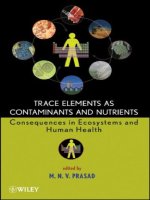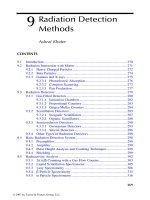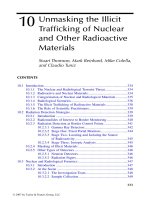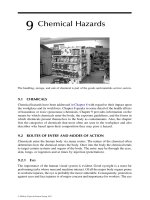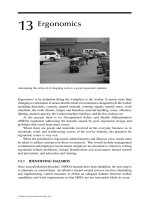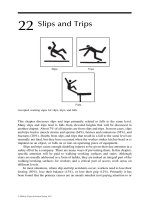Ecosystems and Human Health - Chapter 9 pptx
Bạn đang xem bản rút gọn của tài liệu. Xem và tải ngay bản đầy đủ của tài liệu tại đây (72.19 KB, 17 trang )
©2001 CRC Press LLC
chapter nine
Pesticides
So naturalists observe, a flea has smaller fleas that on
him prey; And these have smaller still to bite ’em; And
so proceed
ad infinitum
.
— Jonathan Swift
Introduction
The term
pesticides
refers to a large body of diverse chemicals that includes
insecticides, herbicides, fungicides, rodenticides, and fumigants employed
to control one or more species deemed to be undesirable from the human
viewpoint. Pesticides are of environmental concern for two main reasons.
Although considerable progress has been made with respect to their selective
toxicity, many still possess significant toxicity for humans, and many are
persistent poisons, so that their long biological t
1/2
allows bioaccumulation
and biomagnification up the food chain (see Chapter 3). Thus, there is the
possibility that, besides constituting an ecological hazard, they may enter
human food supplies. By their very nature, pesticides must have an impact
on any ecosystem because they are designed to modify it by their selective
elimination of certain species. As is always the case in considering chemicals
used in the service of humankind, there is a complex risk–benefit equation
that must be taken into account when making decisions regarding the use
of pesticides. There is no question that they have increased agricultural
production when used properly, and they have, in the past, been highly
effective in controlling the insect vectors of human diseases such as malaria
and yellow fever spread by mosquitoes and African sleeping sickness which
affects both humans and animals and is spread by the tse-tse fly. As will be
seen, however, these gains have not been without their problems.
Efforts to control agricultural pests probably evolved in parallel with
cultivation techniques. Early methods included manual removal of weeds
and insects, rigorous hoeing to prevent weed growth, and the use of traps
for animal and insect pests. The first chemical controls to be used against
agricultural pests were the arsenical compounds. In 1910, Ehrlich discovered
that arsphenamine was an effective treatment for syphilis. This was the first
©2001 CRC Press LLC
chemotherapeutic agent for a bacterial infection and the first example of a
structure–activity relationship. It opened the door to the entire field of chem-
ical control of both infections and of pests. Paracelsus had introduced the
use of inorganic arsenicals, notably arsenic trioxide (As
2
O
3
, white arsenic),
into medicine in the sixteenth century but its use was limited by its extreme
toxicity. Ehrlich’s discovery revived interest in these compounds. In 1824 the
Colorado potato beetle was discovered east of the Rockies and its eastward
spread accelerated the search for an effective control. As
3
O
3
was found to be
effective and came into widespread use. Other arsenicals were developed,
including Paris green (copper arsenite) which is still used as slug bait. Being
a heavy metal, arsenic is persistent in the environment, the significance of
which was not appreciated when it was being widely used.
Natural-source insecticides also evolved fairly early on. Certain plants
have been employed as fish poisons in Southeast Asia and in South America
for centuries and in 1848 a decoction of derris root was used to control an
insect infestation in a nutmeg plantation in Singapore. By 1920, large
amounts of derris root were being imported into North America. The active
ingredient is rotenone, and it has the advantages of low mammalian toxicity
and a short t
1/2
in nature. Pyrethrum flowers (chrysanthemums) have been
known for their insecticidal properties for centuries. Commercial manufac-
ture began in 1828. In 1945, the United States imported 13.5 million pounds.
By 1954, this had fallen to 6.5 million because of the widespread use of DDT,
the banning of which has led to a resurgence of use of pyrethrin compounds.
Nicotine sulfate (Blackleaf 40 is a 40% solution) from tobacco is used to
control aphids and other insects. It has a short biological t
1/2
but significant
mammalian toxicity.
The mechanization of farming led to a second agricultural revolution by
making possible the planting and cultivation of vast tracts of land. Pest
control techniques also changed from the small-scale operations of the past
to include mechanized spraying from the ground and the air. This involved
a marked increase in the use of pesticides and it coincided with the intro-
duction of the first modern synthetic insecticide, DDT.
Dichlorodiphenyltrichloroethane, or DDT, was first synthesized in 1874
but its insecticidal properties were not recognized until 1939. Its structural
formula is shown in Figure 31. Its first major use occurred in Sicily in 1943,
where it was used to halt an epidemic of tick-borne typhus.
Figure 31
DDT: chemically 1,1,1-trichloro-2,2-bis- (p-chlorophenyl) ethane.
Cl
H
CCl
C
Cl
Cl Cl
©2001 CRC Press LLC
Sometimes called the grandfather of all chlorinated aromatic hydrocar-
bons, DDT was the first of such agents to arouse environmental concern.
Rachael Carson’s
Silent Spring
called attention to the ecological damage
caused by DDT and led to its banning in the United States and Canada in
1972. Prior to that, however, its use had led to the eradication of malaria in
37 countries and dramatically reduced its incidence in a further 80, providing
relief to 1.5 billion people. Its effectiveness in controlling agricultural pests,
coupled with its low mammalian toxicity (oral LD
50
= 113 mg/kg, dermal
LD
50
= 2.5 gm/kg), resulted in extensive use in North America. U.S. produc-
tion reached 50,000 metric tonnes annually. The availability of cheap surplus
aircraft after World War II resulted in the spraying of huge areas to control
pests of not only agricultural but human as well. Organochlorines, including
the cyclodienes, dominated the insecticide field until the early 1960s, when
organophosphates and carbamates were developed. These, plus the devel-
opment of more disease-resistant hybrid crops, led to the Green Revolution
of the 1960s, with dramatic increases in food production.
Classes of insecticides
Organochlorines (chlorinated hydrocarbons)
As already discussed, the parent compound of this group is DDT. Its human
toxicity is extremely low. In one rather heroic experiment, volunteers were
fed 35 mg/day for up to 25 months without obvious ill effects. Another study
of 35 male workers who had DDT levels in fat and liver 80 times the Amer-
ican average, and who had worked in a manufacturing plant for up to 19
years, showed no ill effects. DDT is, however, a potent inducer of cytochrome
P450 hepatic microsomal enzymes and may thus affect the rate of biotrans-
formation of other chemicals and drugs. Extremely high doses cause neuro-
logical signs and symptoms, including numbness of the tongue, lips, and
face; dizziness; hyperexcitability; tremor; and convulsions.
DDT has very high lipid solubility and it is sequestered in body fat.
Virtually everyone who was alive after 1940 has DDT in body fat. In the
1960s, significant amounts were found in people all over the world from Sri
Lanka to North America. In 1970, the mean concentration in human fat was
7.88 ppm. After the ban, it fell to 4.99 in 1975. There is no evidence that
chronic exposure to DDT has resulted in any health problems. In insects,
DDT opens up ion channels to prevent normal axonal repolarization. Disor-
ganized neuronal function leads to death.
Other life forms are not as resistant as humans. Fish are extremely
vulnerable, and dieoffs have occurred after heavy rains washed DDT into
streams and lakes. Deformities also occur. Predatory birds at the top of the
food chain are very vulnerable as well. Reproduction is disturbed in a num-
ber of ways. DDT induces cytochrome P450 to increase estrogen metabolism
and DDT itself has estrogenic activity that affects fertility. Ca
2+
-ATPase is
inhibited, as is calcium deposition in eggshells. This effect is largely due to
©2001 CRC Press LLC
stable metabolites, notably DDE (dichlorodiphenyldichloroethane). Some
bird species are only now recovering. The limited use of DDT against the
tussock moth was re-approved in the United States in 1974 and its use in
malarial areas has continued without interruption, so that DDT exposure on
a worldwide basis still occurs.
The cyclodienes are a subgroup of the organochlorines. This group
includes aldrin, dieldrin, heptachlor, and chlordane. Their mechanism of
insecticidal action is the same as for DDT, but their toxicity for humans is
much greater because of more efficient transdermal absorption. Signs of
excessive CNS excitation and convulsions occur before less serious signs
appear. Several deaths, mostly in those who handled the pesticide, have
occurred. These agents are also persistent in the environment. There is con-
cern about their potential for carcinogenicity because this has been shown
in some animals. However, Ribbens reported on a study of 232 male workers
who had been exposed to high levels of cyclodienes in a manufacturing plant
in Holland for up to 24 years (mean = 11 years). Mortality and cancer
incidence were compared to the means for the Dutch male population of the
same age group. The observed mortality in the group was 25, which was
significantly lower than the expected mortality of 38. Nine of the deaths were
from cancer, as opposed to an expected incidence of 12. These workers had
been exposed to very high levels of cyclodienes in the early days of manu-
facture, with recorded dieldrin blood levels of up to 69
µ
g/L at some time
in their history.
Other organochlorines include methoxychlor, lindane, toxaphene, mirex,
and chlordecone (kepone). Mirex and kepone are extremely persistent, toxic
to mammals (CNS toxicity), and carcinogenic in animals. They also induce
cytochrome P450. They are no longer used in North America. Lindane shares
the same toxicity but is much less persistent and is used to treat head lice.
Lindane (chemically 1,2,3,4,5,6-hexachlorocyclohexane) is the active isomer
of benzene hexachloride. Toxaphene induces liver tumors in mice and is
fairly toxic; its use is declining. Methoxychlor is similar to DDT but it is
much less persistent and less toxic to mammals, which can metabolize it. It
also is stored in fat to a much lesser degree. Its formula, along with that of
lindane, is shown in Figure 32. The carcinogenic and reproductive toxicity
of organochlorines is dealt with in Chapter 12.
Figure 32
Chemcial structures of methoxychlor and lindane.
METHOXYCHLOR
LINDANE
CH
3
O
CH OCH
3
CCl
3
Cl
Cl
Cl
Cl
Cl
Cl
©2001 CRC Press LLC
Organophosphorus insecticides
These insecticides, often referred to as organophosphates, are the most fre-
quent cause of human poisonings. The group includes parathion, dichlorvos
(present in Vapona strips), and diazinon. They all act as irreversible inhibitors
of acetylcholinesterase, so that the neurotransmitter acetylcholine is not inac-
tivated following its release from the nerve terminal. Signs and symptoms
are those of a massive cholinergic discharge and include dizziness and dis-
orientation, profuse sweating, profuse diarrhea, constricted pupils, and
bradycardia (slowing of the heart), possibly with arrhythmias. Parathion has
a dermal LD
50
of 21 mg/kg and an oral LD
50
of 13 mg/kg in male rats, but
the NOEL in both rats and humans is only 0.05 mg/kg. Parathion itself is
not toxic but it is transformed in the liver to para-oxone, its oxygen analog
(see Chapter 1, Figure 3).
The following is a typical case history of organophosphorus poisoning.
A 52-year-old white, male farmer was admitted to a hospital emergency
department following a highway accident in which his tractor collided with
the rear of a motor vehicle about to make a turn. He incurred numerous
lacerations and contusions and a fractured right humerus. He was restless
and incoherent and required physical restraint. His pupils were bilaterally
constricted, his heart rate was 55 beats/min, and he was sweating profusely.
His clothing had a strong, chemical odor. His wife volunteered that he had
had several episodes of visual difficulty over the preceding 2 weeks. Further
questioning revealed that he had been spraying organophosphorus insecti-
cides during this period (organophosphorus poisoning is frequently
delayed). Atropine was given intravenously in repeated small doses until
the signs of cholinergic discharge abated. Another drug that can be used is
pralidoxime, which complexes with the phosphate component of the orga-
nophosphorus and releases the cholinesterase. The principal advantage of
the organophosphates is their short life in the environment. The sites of
action of organophosphates, atropine, and pralidoxime are shown in
Figure 33.
Delayed neuropathy is another form of organophosphorus poisoning.
In the 1930s, during prohibition, thousands of people in the southern United
States became paralyzed after drinking an alcohol extract of Jamaica ginger.
The preparation was found to be contaminated with triorthocresylphos-
phate. The first clinical cases associated with the insecticides occurred in a
pilot plant making an organophosphorus insecticide (mipafox) in 1953.
Administration of the chemical to chickens caused similar neurological dis-
turbances, including paralysis, and pathology of the axons. In humans, the
clinical picture is one of severe polyneuritis commencing a few days after a
sufficient single exposure or cumulative exposures. Initially, mild sensory
disturbances, weakness, and fatigue, especially of the legs, are seen. The
condition can progress to flaccid paralysis and eventually to spastic paraly-
sis. The medium and large peripheral nerves are damaged, with axonopathy
being the principal lesion and demyelination also occurring. Treatment
involves massive doses of atropine. Inhibition of acetylcholinesterase is not
©2001 CRC Press LLC
involved in this toxic reaction. Current theory is that some, but not all,
organophosphorus agents inhibit an esterase essential for axonal function.
Only certain triarylphosphates and fluorine-containing alkylphosphates
appear able to induce the lesions, both clinically and experimentally. The
esterase has been named neuropathy target esterase (NTE). Evidence for this
enzyme is indirect because it has not been isolated in active form and no
physiological role for it has been established. It appears to be tightly bound
to the nerve membrane.
Carbamate insecticides
Carbamates (e.g., Sevin) are also inhibitors of acetylcholinesterase, but they
do not require metabolic activation and they are reversible. They are not
persistent in the environment. Because they lack the phosphate group, prali-
doxime cannot be used for treatment of poisoning. In fact, it is contraindi-
cated because it may tie up more reactive sites on the enzyme and increase
the degree of inhibition. This group includes aldicarb (Temik
®
), carbaryl, and
Baygon
®
. The dermal LD
50
for aldicarb in male rats is 3.0 mg/kg. It is also
fairly toxic to humans. Although these agents are generally not persistent in
Figure 33
Sites of action of organophosphate insecticides, atropine, and pralidoxime.
Although the neurotransmitter site is labeled a synapse, atropine is primarily a
muscarinic receptor-blocking agent, acting at parasympathetic effector junctions.
Acetylcholinesterase is present there, as well as in all ganglia, at the neuromuscular
junction, the brain, and the adrenal gland.
acetylcholine (ACh)
organophosphate
atropine
pralidoxime
pralidoxime-organophosphate
complex
ACh-ase functional
ACh-ase blocked by organophosphate
ACh receptors functional
ACh receptors
protected by atropine
SYNAPSE
storage granules
©2001 CRC Press LLC
the environment, aldicarb may be an exception. Under certain conditions
(sandy soil over aquifers), it may reach water supplies and persist for a
considerable time. In Long Island, New York, it has been estimated that the
levels of 6 ppb may persist for up to 20 years.
Botanical insecticides
The more common botanical insecticides were discussed briefly above. While
it is commonly felt that natural-source insecticides are safer than synthetic
ones (another example of the “nature knows best” syndrome), this is not
necessarily so. Pyrethrins and rotenone have oral LD
50
values of about 600
to 900 mg/kg and 100 to 300 mg/kg, respectively. Nicotine is quite toxic,
with an oral LD
50
of 10 to 60 mg/kg. The main problem with pyrethrins has
been the rapidity with which they are destroyed in the environment. Newer
ones have been isolated with longer half-lives to permit more effective kills.
Herbicides
Chlorphenoxy compounds
These agents, characterized by 2,4-D and 2,4,5-T, act as growth hormones,
forcing plant growth to outstrip the ability to provide nutrients. They are
employed as a variety of salts and esters. The acute toxicity of these agents
is relatively low, with LD
50
values of 300 to 1000 mg/kg reported for several
species of mammals. The dog may be more sensitive (LD
50
= 100 mg/kg).
Ventricular fibrillation appears to be the immediate cause of death. Acute
toxicity in humans is manifested largely as chloracne.
The main concern about 2,4,5-T is the likelihood of its contamination
with dioxin (TCDD). This subject is dealt with in Chapters 2 and 4. The
chemical structures of these compounds are shown in Figure 34.
Dinitrophenols
Several substituted dinitrophenols are used as herbicides, the most common
probably being Dinoseb (see Figure 35). It has been reported to have an LD
50
of 20 to 50 mg/kg in rats. Dinoseb, first registered in 1947, is out of favor
because handlers may be at considerable risk for teratogenic effects,
Figure 34
Chemical structures of 2,4-D and 2,4,5-T.
Cl
OCH
2
COH
Cl
O
Cl
Cl
OCH
2
COH
Cl
O
2, 4-D
2 , 4, 5-T
( 2 , 4-dichlorphenoxyacetic acid )
( 2 , 4, 5-trichlorphenoxyacetic acid)
©2001 CRC Press LLC
cataracts, and male reproductive disturbances, even when protective cloth-
ing is worn. The U.S. EPA suspended all use in 1987.
4,6-Dinitro-
o
-cresol (DNOC, see Figure 35) has caused acute poisoning
in humans with signs and symptoms including nausea, vomiting, restless-
ness, and flushing of the skin, progressing to collapse and coma. Hyperther-
mia may occur. Death may ensue in 24 to 48 hr. Uncoupling of oxidative
phosphorylation is probably the mechanism of toxicity. Atropine is contrain-
dicated because there is no anticholinesterase activity and the CNS effects
of atropine may complicate the outcome. Treatment is symptomatic and
includes ice baths to reduce fever, intravenous fluids, and the administration
of O
2
.
Bipyridyls
Paraquat and diquat are the most familiar members of this group (see
Figure 36). Both are toxic, but their toxicity differs. The principal organ of
toxicity for paraquat is the lungs, although the liver and kidney may also
be damaged. Respiratory failure may be delayed for several days after the
ingestion of paraquat. It appears to be selectively concentrated in the lungs
by an energy-dependent system. Paraquat is believed to undergo conversion
to superoxide radical (O
),
2
which causes the formation of unstable lipid
hydroperoxides in cell membranes. Widespread fibroblast formation occurs
and O
2
transfer to capillary blood is impaired.
Figure 35
Chemical structures of Dinoseb and DNOC.
Figure 36
Chemical structures of paraquat and diquat.
O
2
N
CHCH
2
CH
3
CH
3
NO
3
OH
O
2
N
CH
3
NO
2
OH
DINOSEB
( 2-sec-buty1-4, 6-dinitropheno1 )
DNOC
( 4, 6-dinitro-o-cresol )
H
3
CCH
3
NN
++
PARAQUAT DIQUAT DIBROMIDE
NN
+
+
2Br
-
©2001 CRC Press LLC
Treatment consists of attempts to remove or neutralize any paraquat
remaining in the gastrointestinal tract by gastric lavage, cathartics, and
Fuller’s earth as an adsorbant. In complete lung failure, double lung organ
transplant offers the only hope for recovery.
In contrast, diquat toxicity is centered on the liver, kidney, and gas-
trointestinal tract. Superoxide anion formation is also believed to play a role
in these organs. Poisoning with paraquat is far more common and it has
been used as an instrument of suicide on numerous occasions.
Carbamate herbicides
Unlike the insecticide carbamates, the herbicides do not possess anticho-
linesterase activity. They have low acute toxicity. Dithiocarbamates are used
as fungicides and have similar low acute toxicity; LD
50
values for these agents
are in the g/kg range for rodents.
Triazines
This group, typified by atrazine, is also characterized by low acute toxicity.
Amitrole is a herbicide somewhat related to the triazines. It has similar low
acute toxicity, but has peroxidase-inhibiting activity and has been associated
with tumor formation in the thyroids of rats fed the chemical for 2 years.
Fungicides
A wide variety of agents has been used for their fungicidal properties,
some of them quite toxic. Seed grains treated with mercurials have some-
times entered the human food supply with disastrous results (see Chapter 6).
Pentachlorophenol and hexachlorobenzene are halogenated hydrocarbons
with the toxicity typical of that group (see Chapter 4). Thiabendazole is
a fungicide of low toxicity as evidenced by the fact that it is also used as
an anthelmintic in domestic animals and humans for the eradication
of roundworms.
Dicarboximides
Captan
®
and Folpet
®
are agents of some concern. Structurally similar to
thalidomide, they have been shown to possess similar teratogenic proper-
ties in the chick embryo. Captan has been shown to be mutagenic, carci-
nogenic, and immunotoxic in animals. The EPA has judged Folpet to be a
probable human carcinogen with a lifetime risk of cancer of 2 per million
for lettuce and small fruits, and a total of 5.5 per million when all food
sources are combined.
©2001 CRC Press LLC
Newer biological control methods
The earliest form of biological control no doubt was the development of
strains of plants and animals with a high degree of resistance to disease,
through selective breeding. Observant farmers probably began this process
soon after the domestication process began, and it continues today. Over
40 years ago, as a high-school student, this author worked with Professor
Waddell who developed, at the Ontario Agricultural College, the first strains
of wheat to be resistant to wheat rust, a fungal infestation. Recently, a strain
of American elms with a high degree of resistance to Dutch elm disease has
been developed. Ladybugs have been bred and released to control the cot-
tony cushion scale on oranges in California, and
Bacillus thuringiensis
is used
to control forest pests.
One of the earliest, high-tech biological controls was developed in the
1950s and involves sterilization by radiation of millions of male insects that
are then released to mate with the females. In species in which the female
only mates once, this results in a high frequency of infertile unions with a
resulting decline in the insect population. This method was first used suc-
cessfully to control the screwworm fly in the southern United States. This
fly lays its eggs in wounds in the skin of cattle and other livestock. The larvae
then live on the flesh of the unwilling host. By 1966, the screwworm had
been successfully eradicated in the United States and northern Mexico. It
recently resurfaced in Libya, creating a political dilemma for the United
States. Withholding technological assistance could result in massive infesta-
tions throughout Africa (the fly will also lay its eggs in wounds on humans),
but the alternative was to offer help to Quaddafi. Humanitarian consider-
ations prevailed. This form of biological control has also been used more
recently to control the Mediterranean fruit fly in California.
Analogs of insect hormones have been developed that are highly specific
to a given species. These hormones trigger the molting metamorphosis in
the larval stage so that the larva cannot develop normally and dies.
Pathogenic bacteria exist that can be cultured in commercial quantities
and released to control specific pests. Some agents have been genetically
modified for this purpose, but public concerns about “superbugs” have
blocked approval of all but a few of these. Given that there are no known
bacteria that are infectious for both insects and mammals (as opposed to
insects being vectors for infection), this fear seems unjustified. A more legit-
imate concern is that beneficial or harmless species may also be attacked by
the organisms (see also Chapter 14).
Government regulation of pesticides
Most governments have regulations governing the use of pesticides. The
Canadian regulations are fairly typical of those in place in industrialized
countries. The Pest Control Products Act, administered by Agriculture Can-
ada, regulates the introduction of new pesticides. The risk-benefit principle
©2001 CRC Press LLC
is applied to decisions, that is, the degree of risk must be acceptable in light
of the potential benefit to be derived from pest control with the new agent.
Its relative safety and effectiveness compared to existing pesticides will
influence the decision.
Problems associated with pesticides
Development of resistance
Insects, like microorganisms, possess the most important characteristics for
the evolution of resistant strains: an extremely short reproductive cycle and
the production of vast numbers of progeny. Most species of insects can go
through many generations in one season, producing millions of offspring.
There is thus the capacity for multiple, sequential mutations to occur, and a
good chance that some of these will be resistant to one or more insecticide.
The development of resistance requires the presence of the appropriate insec-
ticide to select out the resistant strain (by killing off the susceptible ones)
with the means of detoxifying the chemical or excluding it from absorption.
Only 3 years after the introduction of DDT, houseflies and mosquitoes were
showing signs of resistance; and by 1951, DDT, methoxychlor, chlordane,
heptachlor, and benzene hexachloride (of which lindane is the active isomer)
no longer had any effect on houseflies which proliferated abundantly. By the
end of 1980, 428 species of insects and acarines (mites, ticks) were classified
as resistant.
In the pre-DDT era, relatively few species developed resistance. This has
been attributed to the multi-site mechanisms of action of earlier pesticides
(making single mutation resistance unlikely) and to their ionic nature, mak-
ing detoxification by metabolism nearly impossible.
Closely related insecticides can be detoxified by the same mechanism
and generally act at the same target site, so that if resistance evolves to one,
either by the evolution of a detoxification process or by modification of the
target molecules, cross-resistance to the others will occur. This type of resis-
tance tends to be under the control of a single gene allele or closely linked
genes. Cross-resistance to DDT and methoxychlor, aldrin, and heptachlor
has developed in this manner.
Multiple resistance
In common with bacteria, protozoa, and cancer cells, insects can develop
resistance to several insecticides. This is referred to as multiple resistance. It
is the result of the existence of several, independent gene alleles producing
resistance to unrelated agents (e.g., organochlorines and synthetic pyre-
thrins, called pyrethroids) with different modes of action and different detox-
ification pathways. It can be a very serious problem of insect control. The
mechanism of multiple resistance is obviously quite different from that of
bacteria, which is discussed in Chapter 8.
©2001 CRC Press LLC
Nonspecificity
Broad-spectrum pesticides, as most are, make no distinction between true
pests and species that are harmless or even beneficial. They, therefore, may
disrupt the natural competition between species to permit the proliferation
of one previously held in check or, as has been observed, they may kill off
predator species and permit the expansion of a prey species, which then
becomes a pest. This has happened with spider mites.
Environmental contamination
A greater danger than direct toxicity to humankind is probably the contam-
ination of the environment and the subsequent bioaccumulation and biom-
agnification that occur with persistent pesticides. These chemicals may end
up in soil, water, air, or all three, depending on their characteristics (see
Chapters 3 and 5). The Great Lakes are accumulating hazardous chemicals
as a result of agricultural runoff and industrial discharges, frequently acci-
dental ones. It must be stressed, however, that the greatest source of chemical
contamination is residential sewage. Even after treatment, phosphates and
other household chemicals may enter the water system. The water table in
many areas has been contaminated with the herbicide atrazine, commonly
used in cornfields.
Callous disregard for the environment can be the result of greedy indi-
viduals attempting to increase their profit margin. There have been numer-
ous cases in Toronto of trucks dumping toxic wastes into Lake Ontario after
dark, in violation of provincial and municipal laws. In the United States,
careless dumping of chlordecone in the James River by a chemical company
resulted in a ban on fishing. This cyclodiene is used in ant and roach baits.
Balancing the risks and the benefits
The widespread use of pesticides means that there are trace quantities
present in or on almost all foodstuffs. Major advances in analytical tech-
niques over the past 20 years mean that chemicals can now be detected at
levels never before possible. Headlines proclaiming that dioxins (or PCBs,
etc.) have been detected in Lake Erie fish seldom go on to say that the
quantities were at the parts-per-billion level. The detection of dioxins in milk,
leached from the carton paper, is an example of this. Actual levels were
comparable to a drop in an Olympic-sized swimming pool.
Nonetheless, there is a growing feeling among the public that the use of
pesticides should be greatly curtailed because the risks are unacceptable or,
what is almost as bad, unconfirmed. In recognition of this, the Ontario
Ministry of Agriculture and Food has established the Foodsystems 2002
program, which will attempt to reduce the use of pesticides in agriculture
in Ontario by 50% by the year 2002. However, the impact of pests on food
production is so great that temporary approval is sometimes granted to new
©2001 CRC Press LLC
agents before all of the required tests have been completed. In 1977, it was
discovered that an American testing company, Industrial Bio-Test Laborato-
ries, had misrepresented toxicological data on numerous agents. Of the 405
pesticides registered in Canada, 106 had been approved partly on the basis
of Bio-Test data. In 1983, Health and Welfare Canada announced that five of
these were to be withdrawn, one being the fungicide Captan, which was
found to be teratogenic and carcinogenic.
Other pesticides that have been banned or that are under investigation
include:
Chlordane
. This cyclodiene was withdrawn in 1986 because it was con-
sidered to be an epigenetic tumor promoter. It is still registered for
use against termites.
Alachlor
. This herbicide was withdrawn in 1985 because of evidence of
carcinogenicity in animals. It was introduced in 1969 and widely used
on corn and soybean crops.
Cyhexatin
. Dow chemical voluntarily withdrew this insecticide because
of evidence of teratogenicity (hydrocephaly) in rabbits.
Toxicity of pesticides for humans
Pesticide applicators are at risk primarily from inhalation and dermal contact
with pesticides. Protective clothing and equipment are important means of
reducing risk. Nonoccupational poisonings occur largely from oral ingestion
of contaminated food although dermal exposure has resulted in poisonings
in infants (the pentachlorophenol treatment of hospital linens) and inhalation
exposure from spray drift can occur. Household pesticides can cause poi-
soning by all three routes.
There have been a few isolated fatalities in North America from acute
pesticide poisoning, but elsewhere in the world, many cases of mass poison-
ings have occurred. Consumption of seed grains treated with hexachloroben-
zene and organic mercury has resulted in mass outbreaks of poisoning in
Turkey, West Pakistan, Iraq, and Guatemala. Accidental contamination of
foodstuffs such as flour, sugar, and grain with parathion and others has
occurred in several places around the world.
Effects of long-term exposure to very low levels of pesticides on human
health remain conjectural but evidence is accumulating that they exist. In
one study in Great Britain, a battery of neuropsychological performance tests
was administered to two groups of males, 16 to 65 years of age. One was a
group of 146 sheep farmers exposed to organophosphates in sheep dip over
several years. The other was a group of matched quarry workers not exposed
to organophosphates. The farmers performed significantly worse on tests of
short-term memory and cognitive function. The tests included simple reac-
tion time, symbol digit substitution, digit span, serial word learning, and
others. There is also the possibility that contaminants may emerge as a
greater risk than the pesticide itself, as was the case with TCDD.
©2001 CRC Press LLC
There is no doubt that persistent poisons can have a catastrophic effect
on the environment and this is probably the most compelling argument for
limiting their use. In 1996, over 4000 Swainson’s hawks were found dead
in a 50 km
2
area in Argentina. The deaths were attributed to the spraying
of crops to kill grasshoppers. The hawks follow tractors that stir up the
grasshoppers and the hawks then feast on them. Ecologists feared that losses
may reach 20,000 birds out of a world population of about 400,000.
There is some hope that nature may be developing her own protective
processes against pesticides. There is some new evidence that fields sprayed
with the same chemicals year after year may develop a population of bacteria
that break down the pesticides and may even adapt to the point that they
use them as a food source. Tests on prairie soils indicated that the organism
Rhodococcus
breaks down thiocarbamate insecticides in the test tube within
2 hours. It may be possible through gene splicing to develop plants that
protect themselves against pesticide residues.
Further reading
Aldridge, W.N.,
Mechanisms and Concepts in Toxicology
, Taylor & Francis Ltd., Lon-
don, 1996.
Carson, R.,
Silent Spring
, Fawcett Crest Books, Greenwich, 1962.
Claus, E.P. and Tyler, V.E., Jr.,
Pharmacognosy
, Lea and Febiger, Philadelphia, 1967.
Flanders, R.V., Potential for biological control in urban environments, in
Advances in
Urban Pest Management
, Bennett, G.W. and Owens, J.M., Eds., Van Nostrand
Reinhold, New York, 1986, 95–129.
Garner, R.J.,
Veterinary Toxicology
, Bailliere, Tindall, London, 1957.
Georghiou, G.P. and Saito, T., Eds.,
Pest Resistance to Pesticides
, Plenum Press, New
York, 1983.
Hardman, J.G. and Limbird, L., Eds. in Chief,
Goodman and Gilman’s The Pharmaco-
logical Basis of Therapeutics
, 9th ed., McGraw-Hill, New York, 1996.
Hall, S.H. and Dull, B.J., Comparison of the carcinogenic risks of naturally occurring
and adventitious substances in food, in
Food Toxicology: A Perspective on the
Relative Risks
, Taylor, S.L. and Scanlon, R.A., Eds., Marcel Dekker, New York,
1988, 205–224.
Klassen, C.D., Amdur, M.O., and Doull, J., Eds.,
Casarett and Doull’s Toxicology: The
Basic Science of Poisons
, 5th ed., McGraw-Hill, New York, 1996.
Murphy, S.D., Toxic effects of pesticides, in
Casarett and Doull’s Toxicology
, 3rd ed.,
Klassen, C.D., Amdur, M.O., and Doull, J., Eds., Macmillan, New York, 1986,
519–581.
McEwen, F.L. and Stephenson, G.R.,
The Use and Significance of Pesticides in the Envi-
ronment
, Wiley Interscience, New York, 1979.
Palca, J., Libya gets unwelcome visitor from the west,
Science
, 249, 117–118, 1990.
Ribbens, P.H., Mortality study of industrial workers exposed to aldrin, dieldrin and
endrin,
Int. Arch. Occup. Environ. Health
, 56, 1985, 75–79.
Schneider, M-J.,
Persistent Poisons
, New York Academy of Science, New York, 1979.
Stephens, R., Spurgeon, A., Calvert, I.A., Beach, J., Levy, L.S., Berry, H., and
Harrington, J.M., Neuropsychological effects of long-term exposure to orga-
nophosphates in sheep dip,
Lancet
, 345, 1135–39, 1995.
©2001 CRC Press LLC
Williams, D.E., Dashwood, R.H. et al., Anticarcinogens and tumor promoters in foods,
in
Food Toxicology: A Perspective on the Relative Risks
, Taylor, S.L. and Scanlan,
R.A., Eds., Marcel Dekker, New York, 1989, 101–150.
Review questions
For Questions 1 to 8, use the following code:
Answer A if statements a, b, and c are correct.
Answer B if statements a and c are correct.
Answer C if statements b and d are correct.
Answer D if only statement d is correct.
Answer C if all statements (a, b, c, d) are correct.
1. Which of the following statements is/are true?
a. Lindane is commonly used for the control of head lice.
b. Toxicological testing is usually performed only on the active in-
gredient of an insecticide.
c. Lindane is an organochlorine.
d. A cause-and-effect relationship for progressive chronic disease
resulting from prolonged pesticide use is well-established.
2. Which of the following is/are true?
a. The herbicide “atrazine” has contaminated the water table in
many areas.
b. Eggshell strength is adversely affected by contact with pyre-
throids by the female bird.
c. The fungicide “Captan” is a teratogen and carcinogen in experi-
mental animals.
d. Natural pesticides are always safer than synthetic ones.
3. The main reason(s) for the carcinogenicity in animals of the herbi-
cides 2,4,-D and 2,4,5,-T is/are:
a. Their action as growth hormones.
b. Their mutagenicity.
c. Their photosensitizing properties.
d. The presence of dioxin (TCDD) as a contaminant.
4. The mechanism of TCDD carcinogenicity in humans may involve:
a. Its pleiotropic response to the Ah locus.
b. Its conjugation with glutathione.
c. Its lack of gene restriction.
d. Its ability to cause chloracne.
5. The insecticide parathion:
a. Is an organochlorine.
b. Is biotransformed by a mixed-function oxidase to its toxic form.
c. Biomagnifies in the environment.
d. Causes symptoms that can be treated with atropine.
©2001 CRC Press LLC
6. Which of the following statements concerning DDT is/are incorrect?
a. It has a low acute LD
50
.
b. It is very persistent in the environment.
c. It is very water soluble.
d. It is still used for mosquito control in many places.
7. Which of the following statements is/are true?
a. Organophosphates are very persistent in the environment.
b. Organophosphates are inhibitors of acetylcholinesterase.
c. Carbamate insecticide poisoning can be treated with pralidoxime.
d. Carbamate insecticides act as reversible inhibitors of acetylcho-
linesterase.
8. Which of the following statements is/are true about insect resistance
to insecticides?
a. Over 400 species of insects, mites, etc. showed resistance to pes-
ticides by 1980.
b. Resistance to pre-organic insecticides is especially prevalent.
c. Cross-resistance to closely related chemicals may occur.
d. Resistance is more likely to occur if an insecticide has several sites
of action.
Answers
1. A
2. B
3. D
4. A
5. C
6. C
7. C
8. B
Case study 18
A 43-year-old male crop-duster was admitted to the emergency department
of a rural hospital following an accident in which the aircraft he was attempt-
ing to land on a grass strip hit hard, collapsed the undercarriage, and nosed
over. The pilot suffered numerous lacerations and bruises but no serious
injuries. He was restless and incoherent and he had to be physically
restrained. A rapid breath alcohol test was performed and it was negative.
His pupils were constricted, his heart rate was slowed, and he was sweating
profusely. His ground assistant volunteered the information that the pilot
had complained of visual disturbances on several occasions during the pre-
vious few days. His clothing smelled strongly of a chemical.
©2001 CRC Press LLC
Q.
Some of these symptoms could be due to a head injury or to chemical
intoxication. What facts point to the latter?
Q.
What information would you want to seek from his assistant?
The ground crew revealed that the pilot had been spraying crops with
parathion during the preceding two weeks.
Q.
What class of pesticide is this?
Q.
What drugs would be indicated for treatment?
Q.
How would treatment differ if a carbamate insecticide such as Sevin had
been used?
Q.
What blood test might assist in confirming the diagnosis?
Case study 19
During the months of June and August of 1993, 26 men, 19 to 72 years of
age, were admitted to three different local hospitals with an array of symp-
toms that included nausea, vomiting, dizziness, visual disturbances, muscle
weakness, abdominal pain, headache, sweating, and excessive salivation.
The men all worked in apple orchards, 19 different ones in total.
Q.
What do these symptoms suggest?
Q.
What inquiries would you want to make of these men?
Q.
What inquiries would you want to make of the orchard operators?

